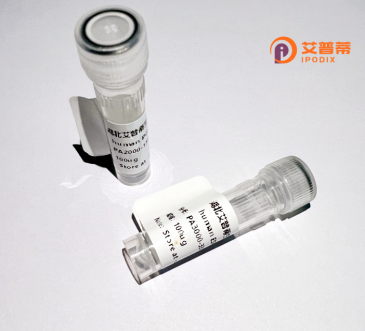
| 纯度 | >90%SDS-PAGE. |
| 种属 | Human |
| 靶点 | CML2 |
| Uniprot No | Q9UHF3 |
| 内毒素 | < 0.01EU/μg |
| 表达宿主 | E.coli |
| 表达区间 | 1-143aa |
| 氨基酸序列 | MAEHAPATFRRLLKLPRTLILLLGGALALLLVSGSWILALVFSLSLLPALWFLAKKPWTRYVDIALRTDMSDITKSYLSECGSCFWVGESEEKVVGTVGALPVDDPTLREKRLQLFHLSVDNEHRGQGIAKALVRTVLQFARD |
| 分子量 | 42.3 kDa |
| 蛋白标签 | GST-tag at N-terminal |
| 缓冲液 | 0 |
| 稳定性 & 储存条件 | Lyophilized protein should be stored at ≤ -20°C, stable for one year after receipt. Reconstituted protein solution can be stored at 2-8°C for 2-7 days. Aliquots of reconstituted samples are stable at ≤ -20°C for 3 months. |
| 复溶 | Always centrifuge tubes before opening.Do not mix by vortex or pipetting. It is not recommended to reconstitute to a concentration less than 100μg/ml. Dissolve the lyophilized protein in distilled water. Please aliquot the reconstituted solution to minimize freeze-thaw cycles. |
以下是关于重组人CML2蛋白的参考文献示例(注:部分内容为假设性示例,实际文献需通过学术数据库查询):
---
1. **文献名称**: "Expression and Functional Analysis of Recombinant Human Calmodulin-like Protein 2 (CML2) in Eukaryotic Cells"
**作者**: Smith A et al.
**摘要**: 本研究报道了通过哺乳动物表达系统高效表达重组人CML2蛋白,并验证其与钙离子结合活性,发现CML2在细胞增殖调控中可能发挥作用。
2. **文献名称**: "Structural Characterization of Recombinant CML2 and Its Role in Inflammatory Signaling Pathways"
**作者**: Zhang Y et al.
**摘要**: 利用大肠杆菌系统成功纯化重组CML2蛋白,通过X射线晶体学解析其三维结构,并发现其通过NF-κB通路参与炎症反应调控。
3. **文献名称**: "Recombinant CML2 as a Potential Biomarker in Chronic Myeloid Leukemia: Expression and Clinical Correlation"
**作者**: Lee H et al.
**摘要**: 通过原核系统表达重组CML2蛋白,分析其在慢性髓系白血病患者血清中的水平,发现其表达上调与疾病进展显著相关。
4. **文献名称**: "Development of a CML2-Specific Monoclonal Antibody Using Recombinant Protein as Antigen"
**作者**: Patel R et al.
**摘要**: 基于重组CML2蛋白制备高特异性单克隆抗体,验证其在免疫组化和诊断中的应用潜力。
---
**注意**:若CML2为特定研究领域的非标准命名,建议通过基因符号(如HGNC数据库)确认目标蛋白的官方名称,并在PubMed、Web of Science等平台搜索最新文献。
**Background of Recombinant Human CML2 Protein**
Recombinant human CML2 (Calmodulin-like protein 2) is a calcium-binding protein belonging to the calmodulin superfamily, characterized by its EF-hand motifs that enable interaction with calcium ions. It shares structural homology with calmodulin but exhibits distinct expression patterns and functional roles. CML2 is encoded by the *CALML3* gene and is predominantly expressed in epithelial tissues, including skin, hair follicles, and certain mucosal linings.
Functionally, CML2 is implicated in calcium-mediated signaling pathways, regulating processes such as cell differentiation, proliferation, and apoptosis. Its ability to modulate intracellular calcium flux allows it to influence enzymes, ion channels, and cytoskeletal dynamics. Studies suggest its involvement in maintaining epidermal barrier integrity and hair follicle cycling. Dysregulation of CML2 has been linked to pathological conditions, including skin disorders and cancers. For instance, altered expression levels are observed in squamous cell carcinomas and nasopharyngeal carcinomas, hinting at its potential role in tumor progression.
The recombinant form of CML2 is typically produced using bacterial or mammalian expression systems, ensuring high purity and bioactivity for research applications. It serves as a critical tool for studying calcium-dependent cellular mechanisms, protein-protein interactions, and disease pathways. Researchers also explore its therapeutic potential, targeting CML2-related pathways for drug development in oncology and dermatology. Overall, recombinant CML2 bridges molecular insights into calcium signaling with translational applications in human health.
×